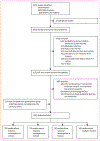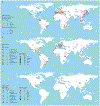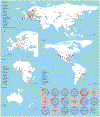Mapping the global distribution of spotted fever group rickettsiae: a systematic review with modelling analysis
- PMID: 36424337
- PMCID: PMC10039616
- DOI: 10.1016/S2589-7500(22)00212-6
Mapping the global distribution of spotted fever group rickettsiae: a systematic review with modelling analysis
Abstract
Background: Emerging and re-emerging spotted fever group (SFG) rickettsioses are increasingly recognised worldwide as threats to public health, yet their global distribution and associated risk burden remain poorly understood.
Methods: In this systematic review and modelling analysis, we mapped global distributions of all confirmed species of SFG rickettsiae (SFGR) detected in animals, vectors, and human beings, using data collected from the literature. We assessed ecological drivers for the distributions of 17 major SFGR species using machine learning algorithms, and mapped model-predicted risks.
Findings: Between Jan 1, 1906, and March 31, 2021, we found reports of 48 confirmed SFGR species, with 66 133 human infections worldwide, with a large spatial variation across the continents. 198 vector species were detected to carry 47 of these Rickettsia spp. (146 ticks, 24 fleas, 15 mosquitoes, six mites, four lice, two keds, and one bug). Based on model-predicted global distributions of the 17 major SFGR species, we found five spatial clusters aggregated by ecological similarity in terms of environmental and ecoclimatic features. Rickettsia felis is the leading SFGR species to which 4·4 billion (95% CI 3·8-5·3 billion) people are at risk, followed by Rickettsia conorii (3·7 billion) and Rickettsia africae (3·6 billion).
Interpretation: The wide spectrum of vectors is contributing substantially to the increasing incidence of SFGR infections among humans. Awareness, diagnosis, and surveillance of SFGR infections should be improved in the high-risk regions, especially in areas where human infections are underreported.
Funding: National Key Research and Development Program of China.
Copyright © 2023 The Author(s). Published by Elsevier Ltd. This is an Open Access article under the CC BY-NC-ND 4.0 license. Published by Elsevier Ltd.. All rights reserved.
Conflict of interest statement
Declaration of interests We declare no competing interests.
Figures





Comment in
-
Enhancing systematic review with machine learning modelling for global health research.Lancet Digit Health. 2023 Jan;5(1):e2-e3. doi: 10.1016/S2589-7500(22)00216-3. Epub 2022 Nov 21. Lancet Digit Health. 2023. PMID: 36424338 No abstract available.
References
Publication types
MeSH terms
Grants and funding
LinkOut - more resources
Full Text Sources
Miscellaneous

